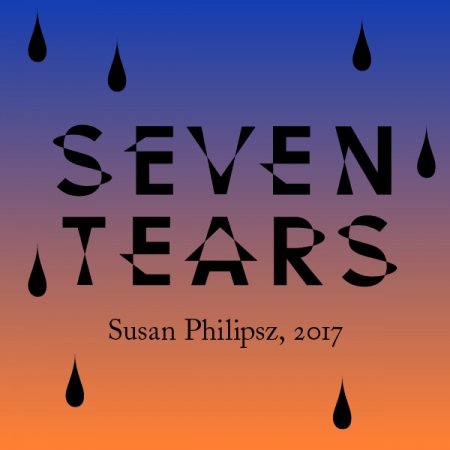Seven Tears by Susan Philipsz to be unveiled on 23d of March
Z-Files, Art and the City #18: lecture, interview and unveiling of Seven Tears (2017) by Susan Philipsz
Location of Z-Files: Museum Boijmans Van Beuningen
Location of unveiling: Willemsplein, Rotterdam
Date: Thursday 23 March, starting at 16:30
On Thursday the 23rd of March, a new sound artwork, specially made for the plaza under the Erasmus Bridge by Scottish artist Susan Philipsz, will be unveiled. The work, Seven Tears, can be heard through seven speakers that are spread around the Willemsplein; the artist based the sound piece on the composition Pavane Lacrimae by Dutch composer Jan Pieterszoon Sweelinck (1562 – 1621).
Due to its ingenious, precise set-up, with speakers specially designed for the purpose mounted on light poles, the sounds and fragments of music mix with the sounds of the city. The sound landscape accompanies the passers-by walking under the bridge along the Maas with striking subtlety, playing each evening during sunset. Seven Tears was commissioned by Sculpture International Rotterdam (SIR) and is an expansion of the SIR collection.
Unveiling and Z-Files #18
Prior to the unveiling of Seven Tears, there will be a lecture and interview with Susan Philipsz in the auditorium of Museum Boijmans Van Beuningen. In this 18th edition of Z-Files, Art and the City, Philipsz will give a presentation about her work Seven Tears, which she designed especially for the Willemsplein, after which Noor Mertens (director of Kunstverein Langenhagen and SIR advisor) will talk with Susan Philipsz about her drives and oeuvre. After the Z-Files, the unveiling of the artwork will take place on the Willemsplein.
Location
The Willemsplein seems, at first glance, to be a surprising location for Philipsz’ work. The Erasmus Bridge, with autos and trams thundering across throughout the day and evening, gulls screeching and boats honking is one of the noisiest places in Rotterdam. But this neglected place in the middle of the bustle of the city, under the bridge, was a perfect location for Philipsz to employ the melancholia of Sweelinck. Sweelinck is the most important Dutch composer of the Early Modern Age, in the transition from renaissance to baroque music.
Pavane Lacrimae
Sweelinck in turn based his Pavane Lacrimae on the song Flow My Tears by his cohort, composer John Dowland (1563 – 1626). This song by Dowland, made for lute and voice, was quite influential at the time. It is one of the first examples of the ‘trend’ of the time of melancholia, the emotional mood often written about at that time.
Seven Tears
Philipsz experimented for the plaza under the Erasmus Bridge – bordered by apartment complexes, the Erasmus Bridge and the Maas- with different kinds of sound. A first-string version was followed by a wind version with organ pipes, followed by the final version. In this version, Sweelinck’s composition is played by musicians on glasses filled with water. The composition refers to the drops of tears as a motif, and the element of Baroque lament, which appeals to the idea of happiness as a fleeting emotion. By spreading the audio across seven channels, the tones and the environmental sounds melt together over time into fragments of sounds.
About the artist
Scottish artist Susan Philipsz (1965, Glasgow) has been using sound for more than 20 years in her work for the public space and art centres. In her work, for which she won the Turner Prize in 2010, she re-arranges and re-interprets existing compositions or pieces of music on the basis of context-specific conditions. Like a sculptor, she explores the spatial qualities of sound and its emotional and cognitive dimensions. Her recent work often revolves around existentialist themes like trauma and sorrow.
Susan Philipsz has exhibited in numerous museums and art centres in Europe and North America. She has realized various projects in the public space, including on Governor’s Island (New York). Philipsz’ work is part of a number of large art collections, including that of the Solomon R. Guggenheim Museum in New York, The Tate in London and Museum Ludwig in Cologne. Her work is represented by gallery Ellen de Bruijne (Amsterdam) and Tanya Bonakdar Gallery (New York).
From North to South
Seven Tears was commissioned by Sculpture International Rotterdam (SIR). SIR is the international programme for art in the public space of CBK Rotterdam. The work is part of the international sculpture collection of Rotterdam. Seven Tears also serves as the prelude for SIR’s leap from the downtown across the river to Rotterdam Zuid. SIR is developing a multi-year programme for Zuid that takes advantage of every opportunity that the art and the city offer, with the area itself as the catalyst. The programme consists, among other things, of expanding the collection with permanent and temporary artworks, research projects, interventions, Z-Files and an international triennial. All of this happens under the working title of Paleis Maashaven.
Colophon
Z-Files, Art and the City #18 is organized by Sculpture International Rotterdam in collaboration with Museum Boijmans Van Beuningen. Seven Tears is made possible in part by the municipality of Rotterdam.
